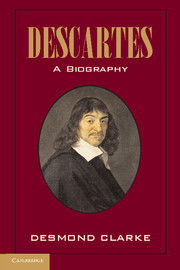Book contents
- Frontmatter
- Contents
- Preface and Acknowledgments
- Note on Texts and References
- Descartes Family Tree
- Introduction
- 1 A Lawyer's Education
- 2 In Search of a Career (1616–1622)
- 3 Magic, Mathematics, and Mechanics: Paris, 1622–1628
- 4 A Fabulous World (1629–1633)
- 5 The Scientific Essays and the Discourse on Method (1633–1637)
- 6 Retreat and Defence (1637–1639)
- 7 Metaphysics in a Hornet's Nest (1639–1642)
- 8 The French Liar's Monkey and the Utrecht Crisis
- 9 Descartes and Princess Elizabeth
- 10 The Principles of Philosophy (1644)
- 11 The Quarrel and Final Rift with Regius
- 12 Once More into Battle: The Leiden Theologians (1647)
- 13 Thoughts of Retirement
- 14 Death in Sweden
- Appendix 1 Descartes' Principal Works
- Appendix 2 Places Where Descartes Lived
- Notes
- Bibliography
- Index
6 - Retreat and Defence (1637–1639)
Published online by Cambridge University Press: 18 July 2009
- Frontmatter
- Contents
- Preface and Acknowledgments
- Note on Texts and References
- Descartes Family Tree
- Introduction
- 1 A Lawyer's Education
- 2 In Search of a Career (1616–1622)
- 3 Magic, Mathematics, and Mechanics: Paris, 1622–1628
- 4 A Fabulous World (1629–1633)
- 5 The Scientific Essays and the Discourse on Method (1633–1637)
- 6 Retreat and Defence (1637–1639)
- 7 Metaphysics in a Hornet's Nest (1639–1642)
- 8 The French Liar's Monkey and the Utrecht Crisis
- 9 Descartes and Princess Elizabeth
- 10 The Principles of Philosophy (1644)
- 11 The Quarrel and Final Rift with Regius
- 12 Once More into Battle: The Leiden Theologians (1647)
- 13 Thoughts of Retirement
- 14 Death in Sweden
- Appendix 1 Descartes' Principal Works
- Appendix 2 Places Where Descartes Lived
- Notes
- Bibliography
- Index
Summary
There is still hardly anyone who has understood fully what I wrote.
(i. 502)Descartes spent the years immediately following publication of the 1637 Essays in seclusion in the north of Holland. As usual, he concealed the various addresses he used from anyone who might disturb him. He moved north from Leiden some time during spring 1637, perhaps as early as April. By May, he reported that he was living in an unidentified location in the Alkmaar region, possibly at Egmond, ‘but without being there because I do not think that I shall remain there’ (i. 634). None of the letters during the following eighteen months, even those sent frequently to his patron, Huygens, gives any indication of his precise address. Thus when Huygens was writing to him from the siege of Breda (which lasted from 23 July to 6 October), he borrowed one of Descartes' phrases from the Discourse to tease his elusive correspondent about the ‘imaginary spaces’ he inhabited. On 29 January 1639, however, Descartes acknowledged that he was in Santpoort, a small village north of Haarlem, though it remains unclear whether he had moved there recently or had been living there for some time previously.
The reasons for the extra secrecy during these years may have been that Helena Jans and her daughter, Francine, were still living with him, although there is no independent evidence to support that suggestion.
- Type
- Chapter
- Information
- Descartes: A Biography , pp. 156 - 183Publisher: Cambridge University PressPrint publication year: 2006



